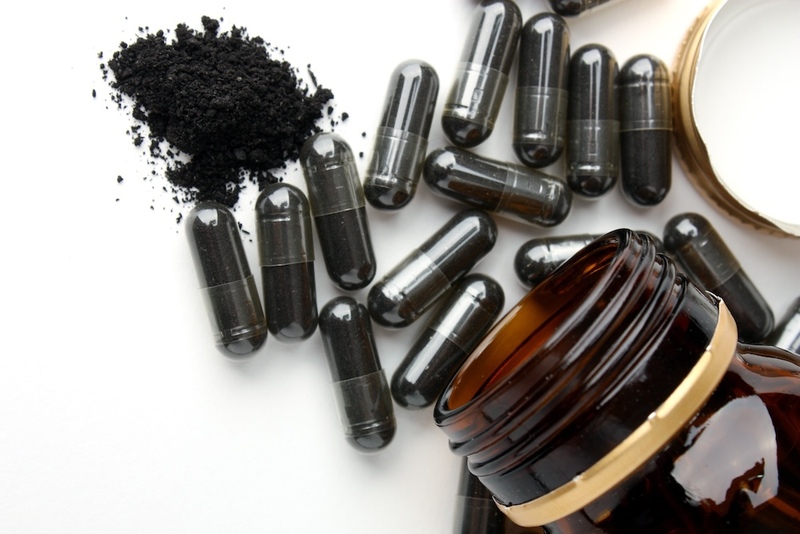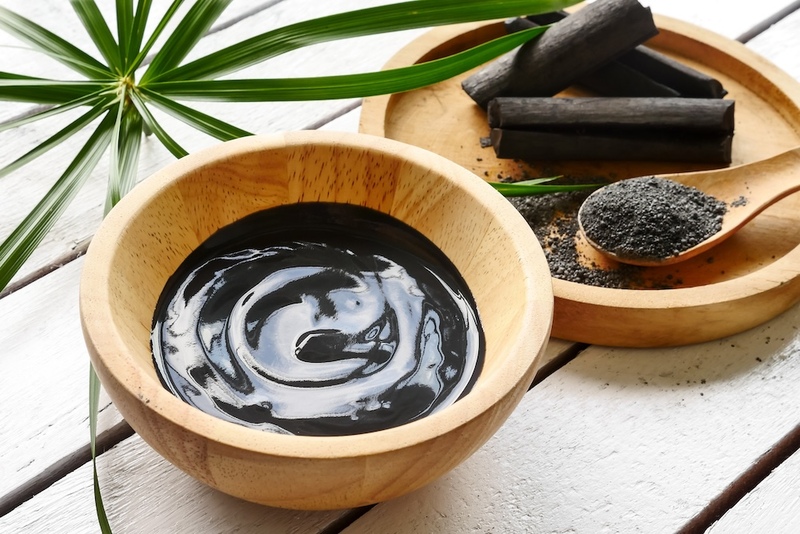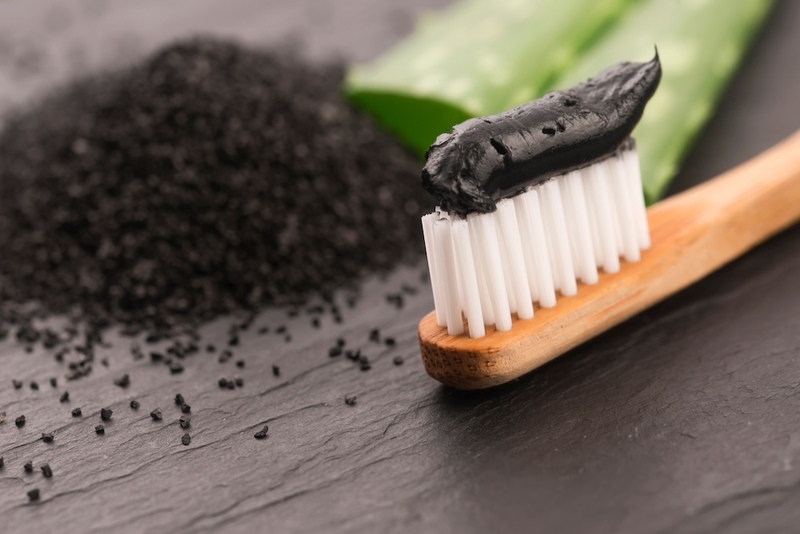
Chunks of charcoal are often left behind in the coals after making a campfire. This charcoal is the carbon that remains from burning wood or other fibrous material after the volatiles and gasses have been burned off. It’s almost pure carbon, but not quite.
Activated charcoal has been processed to remove impurities and increase the carbon's surface area, allowing it to adsorb, not absorb, substances. Charcoal doesn’t absorb things into it, it adsorbs or sticks to them, making it a great agent for purifying things. It's used in various industrial applications as a purifier and is also commonly used to filter water and air. Activated charcoal is readily available in bulk powder and capsule form. It is also possible to make your own activated charcoal,if you are motivated enough.
My first experience with activated charcoal was when one of our kids had a slight touch of jaundice. Our midwife recommended sitting him next to the window to get some sunlight and giving him activated charcoal and safflower tea to remove the bilirubin and gently cleanse the liver. We mixed one capsule of activated charcoal with about ¼ cup of water and gave some in a baby bottle. We also made safflower tea and put that in a baby bottle to administer it. It appeared to work just fine as the jaundice cleared up in a few days.
Activated Charcoal for the GI Tract
 Later I learned about the benefits of activated charcoal on the gastrointestinal tract. Charcoal is a great remedy for bloating, foul belching, and diarrhea. It adsorbs both the gas and the irritants that are causing the diarrhea. For bloating and foul belching, I recommend 2 capsules with each meal taken along with digestive enzymes to help the body break down the food more effectively. I’ve had some problems with this several times in my life and charcoal has always proven helpful.
Later I learned about the benefits of activated charcoal on the gastrointestinal tract. Charcoal is a great remedy for bloating, foul belching, and diarrhea. It adsorbs both the gas and the irritants that are causing the diarrhea. For bloating and foul belching, I recommend 2 capsules with each meal taken along with digestive enzymes to help the body break down the food more effectively. I’ve had some problems with this several times in my life and charcoal has always proven helpful.
For diarrhea, I recommend taking two capsules every two hours up to a maximum of eight capsules per day. For diarrhea in children, I recommend mixing charcoal with slippery elm (1 part charcoal to 2 parts slippery elm) and making a paste out of it with a little apple juice. For children over one-year-old, you can add a little honey to sweeten it. Then you can feed it to the child like a cereal.
Activated Charcoal for Adsorbing Poisons
Charcoal also adsorbs bile salts and the cholesterol they contain, which means it helps to reduce cholesterol. Of course, it also helps to eliminate any toxins being flushed from the liver into the GI tract via the gallbladder.
Because it adsorbs many types of poison, charcoal may be helpful for both food poisoning and chemical poisoning. First aid application may require 15-20 capsules or 50-100 mg of the powder, depending on the quantity and toxicity of the material ingested. However, you should always contact a poison control center and ask them before administering activated charcoal or any other remedy for poison.
Activated Charcoal Poultices for Spider Bites
 I learned about using activated charcoal as a poultice from Home Remedies by Agatha Thrash, MD, and Calvin Thrash, MD. According to them, charcoal is one of the most effective remedies for brown recluse spider bites, which can do horrific damage to the body. It can also be used on other poisonous spider bites. I haven’t tried this on a spider bite, but I did get a painful ant bite once and a charcoal poultice was very helpful for stopping the swelling and the pain.
I learned about using activated charcoal as a poultice from Home Remedies by Agatha Thrash, MD, and Calvin Thrash, MD. According to them, charcoal is one of the most effective remedies for brown recluse spider bites, which can do horrific damage to the body. It can also be used on other poisonous spider bites. I haven’t tried this on a spider bite, but I did get a painful ant bite once and a charcoal poultice was very helpful for stopping the swelling and the pain.
Activated charcoal will not stick together when you mix it with water so you need to combine it with a mucilaginous herb to make a poultice. The Home Remedies book recommends using freshly ground flaxseeds, but you can also use aloe vera gel, marshmallow, or slippery elm. Mix three parts of the mucilaginous herb with one to three parts charcoal and add enough water to make a thick paste. Apply this over the afflicted area and change the poultice every hour. You could also add a plantain tincture or some freshly crushed plantain, which I did with the poultice I used on the ant bite.
Other Uses for Activated Charcoal
 When I took a wilderness first aid class from Sam Coffman, I learned that you can sprinkle powdered activated charcoal onto a puss-filled wound to help clean it out. It will help draw out the pus and dry out the wound. It sticks to bacteria and pathogens and helps destroy them. For this reason, charcoal can also be used as a tooth powder to help fight gingivitis. I personally use a toothpaste that contains charcoal and find it very helpful for my gums along with a mouthwash with xylitol and cinnamon.
When I took a wilderness first aid class from Sam Coffman, I learned that you can sprinkle powdered activated charcoal onto a puss-filled wound to help clean it out. It will help draw out the pus and dry out the wound. It sticks to bacteria and pathogens and helps destroy them. For this reason, charcoal can also be used as a tooth powder to help fight gingivitis. I personally use a toothpaste that contains charcoal and find it very helpful for my gums along with a mouthwash with xylitol and cinnamon.
Activated charcoal is very good for water filtration and can be used to make an emergency water filter. You just need a container with an opening at the bottom, that you can cover with a coffee filter or cheesecloth. Into this container you layer bulk activated charcoal on the bottom, sand on top of that, and gravel at the very top. The water needs to percolate through these layers to filter out the impurities. Here’s an article on making one with a plastic bottle, DIY Charcoal Water Filter, and here’s an article on making a larger one using buckets, How to Filter Water Using Charcoal, Sand, and Gravel.
You can see why I like to keep activated charcoal in my first aid kit. It’s a handy remedy to have on hand for emergencies.
While activated charcoal is non-toxic, there are a few cautions you should observe. First, it can interfere with the assimilation of medicines and nutrients. So, do not take activated charcoal with prescription medications or nutritional supplements. Also, do not take larger doses for more than a few days at a time. One or two capsules a day can be used for a longer period as part of a cleansing program. Large doses may cause constipation.
Steven's Articles
-

-
The Health Benefits and Problems with Coffee
This popular caffeinated beverage can be beneficial…
October
-

-
Understanding Caffeine & Cellular Adaptation
Preserving the power of caffeine's buzz and the…
September
-

-
Horseradish
A pungent spice for aiding protein metabolism…
-

-
Banaba or Crepe Myrtle
A beautiful tree from Southeast Asia whose leaves…
August
-

-
Monkeyflowers
Flower essences to help see ourselves more clearly…
-

-
Mariposa Lilies
Strengthening the bond between mother and child…
-

-
The Noble Bay Leaf
A common kitchen herb for aiding digestion and…
-

-
Epimedium: Horny Goat Weed
A circulatory stimulant and kidney yang tonic…
July
-

-
The Medicinal and Nutritional Benefits of Apricots
A nutritious fruit and valuable medicinal seed for coughs
-

-
Dogwoods
Asian dogwood is used to stop excessive discharge,…
June
-

-
Neem: The Village Pharmacy
A popular Ayurvedic remedy for dental and immune…
-

-
Spilanthes: The Toothache Plant
A traditional remedy for teeth and gums, as well…
-

-
Forsythia
An anti-inflammatory, fever-reducing, and infection fighting herb
May
-

-
Buckwheat (Kashi)
A delicious, high protein, gluten-free, gut-healthy food
-

-
Leaky Gut Syndrome
Plugging the leaks on the underlying cause of…

